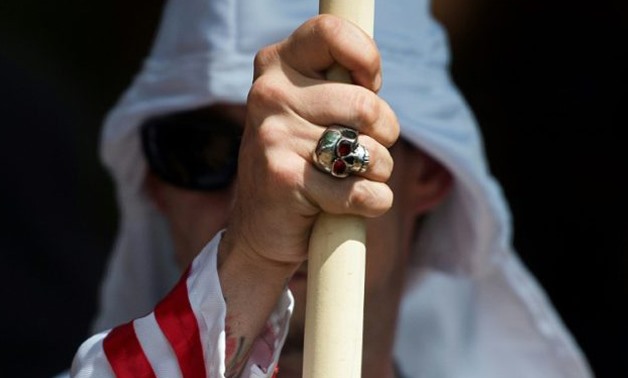
A member of the Ku Klux Klan looks on during a rally, calling for the protection of Southern Confederate monuments, in Charlottesville, Virginia on July 8, 2017. (AFP Photo/ANDREW CABALLERO-REYNOLDS)
Charlottesville, United States, July 11 2017 (AFP) -Even if the US extreme right and white nationalism are enjoying a revival under President Donald Trump, the Ku Klux Klan -- which rallied in Virginia last weekend -- is a mere shadow of its once-powerful former self.
"Today the Klan is mostly a collection of small, disjointed groups, with no central leadership, very little stability," Oren Segal, director of the Anti-Defamation League's Center on Extremism, told AFP.
"These Klan groups tend to form and dissolve very quickly, there are very few groups that have a long history of existence, and in general the Klan is not a particularly healthy white supremacist movement," he said.
The images of men in traditional white robes at Saturday's rally in Charlottesville, Virginia, dredged up fearsome memories of the burning crosses, public lynchings and vast torchlit parades of the Klan's heyday.
In fact, only around 40 members of the Loyal White Knights of the Ku Klux Klan actually showed up for the gathering, vastly outnumbered by hundreds of anti-racist counter-protesters.
The "Knights" wanted to protest the removal of a statue of Robert E Lee, the commander of the pro-slavery Confederate forces in the US Civil War, from a municipal park. But their speeches and denunciations were drowned out by the boos and jeers of protesters.
Still, experts insist the extreme right is on the rise in the United States, emboldened by Trump's victorious president campaign.
The far-right's resurgence comes at a time "when we are having important conversations about race," said Robin Lenhardt, director of the Center on Race, Law and Justice at Fordham Law School.
She points to the mass incarceration of African-Americans in the country's prisons, the abuse of minorities by police, including frequent high-profile shootings, as among the sensitive issues that some conservative white Americans would rather sweep under the carpet.
And there is also the issue of the Confederate flags and monuments still scattered across the South, which have been increasingly challenged since a self-declared white supremacist went on a killing rampage in an African American church in South Carolina two years ago.
"These monuments stand as markers or efforts to memorialize a period when white supremacy reigned," she said.
At the end of June, a group of white nationalists even organized a public gathering in the heart of Washington, close to the Lincoln Memorial where Martin Luther King once made his celebrated "I have a dream" speech.
"There has been an awakening," Richard Spencer, a sworn enemy of multiculturalism and a leader of the self-proclaimed "alt-right" movement told the assembly there.
The "alt-right" has the wind in its sails right now, and is trying to draw together under its flag all the disparate elements of the white American nationalist identity, which it says is under threat from globalization and immigration.
Against that backdrop, the KKK is seen as a much more archaic organization.
"Klans are very much seen as sort of an older generation white supremacy, so they are not attracting young members to the degree that they were many years ago," said Segal. "They suffer from a lack of cohesion."
"Much of their activity is putting fliers on people's lawn, which in many ways is a sign of weakness, not a sign of strength," he said.
At its peak in the 1920s, the Klan had some four million members, was well organized and wielded considerable political clout, with its tendrils even reaching at times into law enforcement agencies.
These days, it can muster only about 5,000 to 8,000 members, according to the Southern Poverty Law Center, which monitors extremist groups
seb/jh/jm


Comments
Leave a Comment